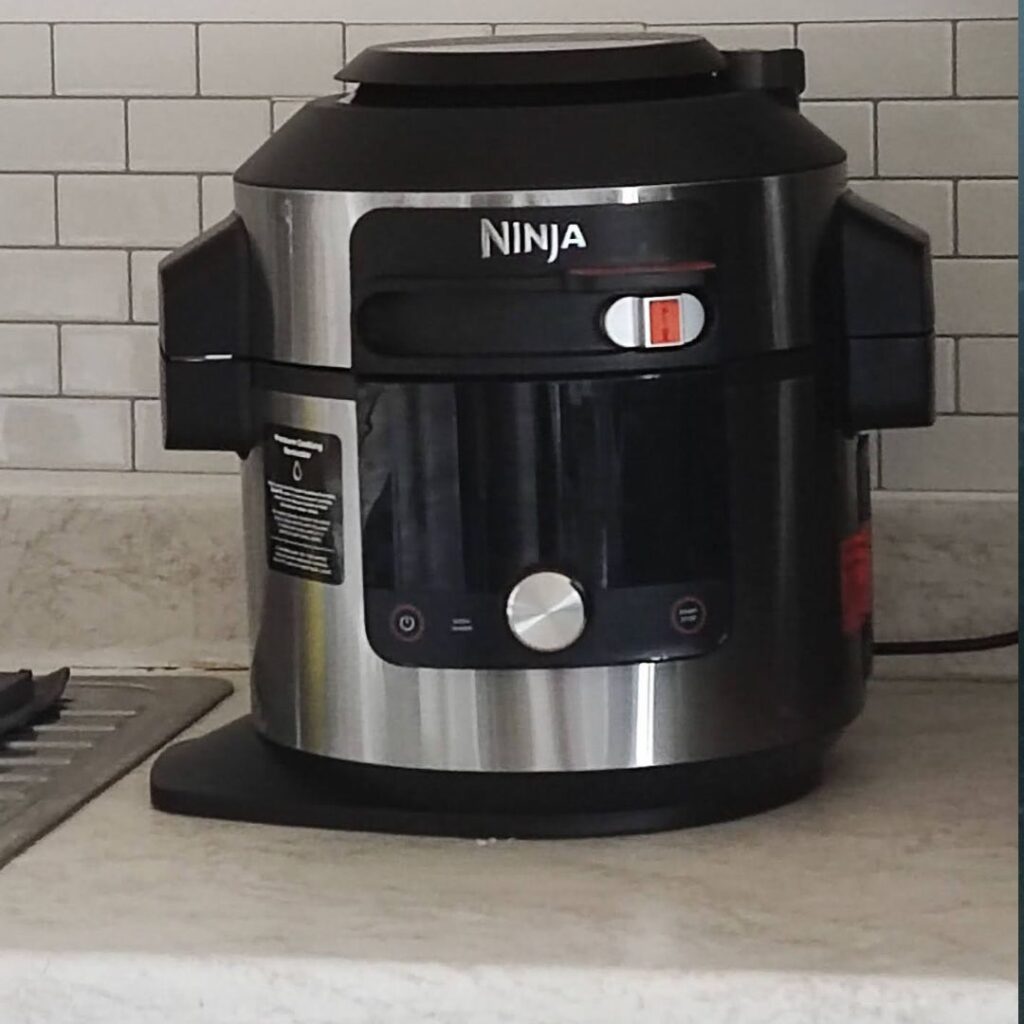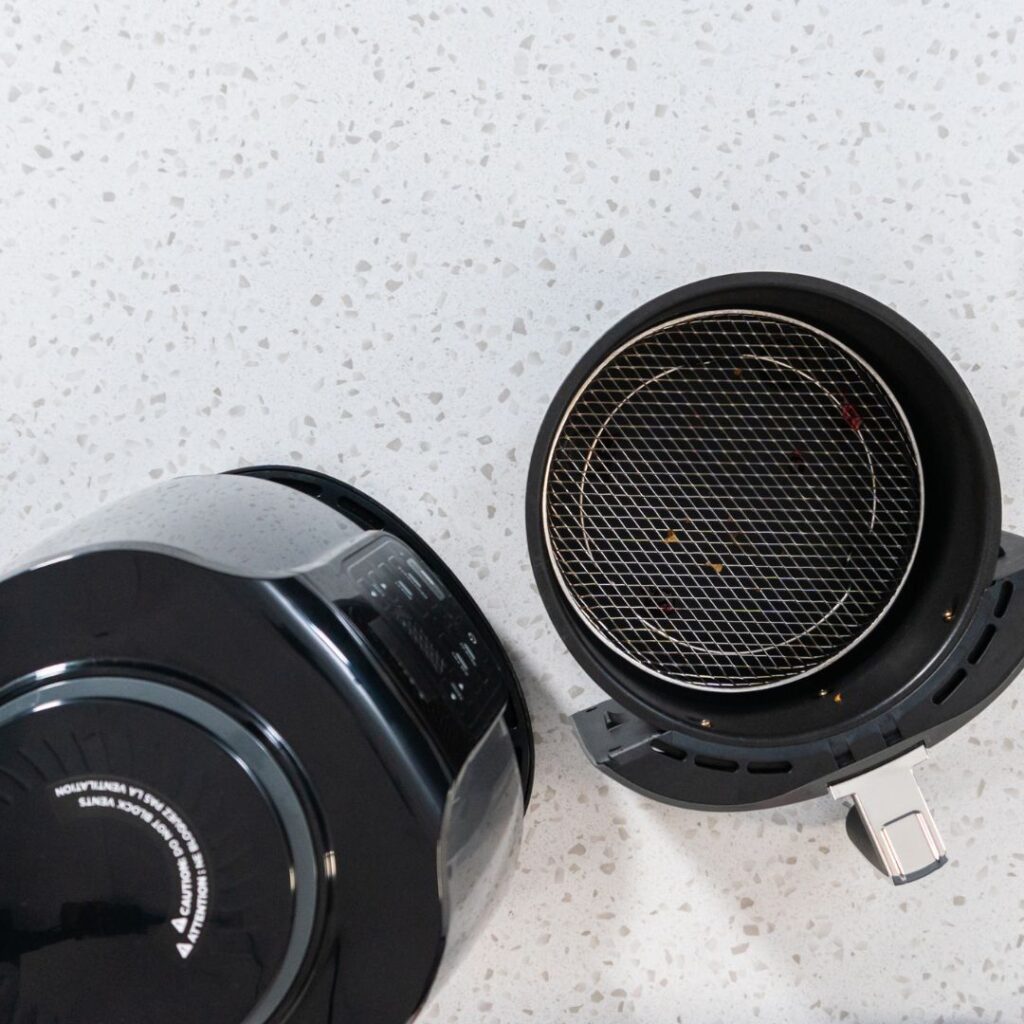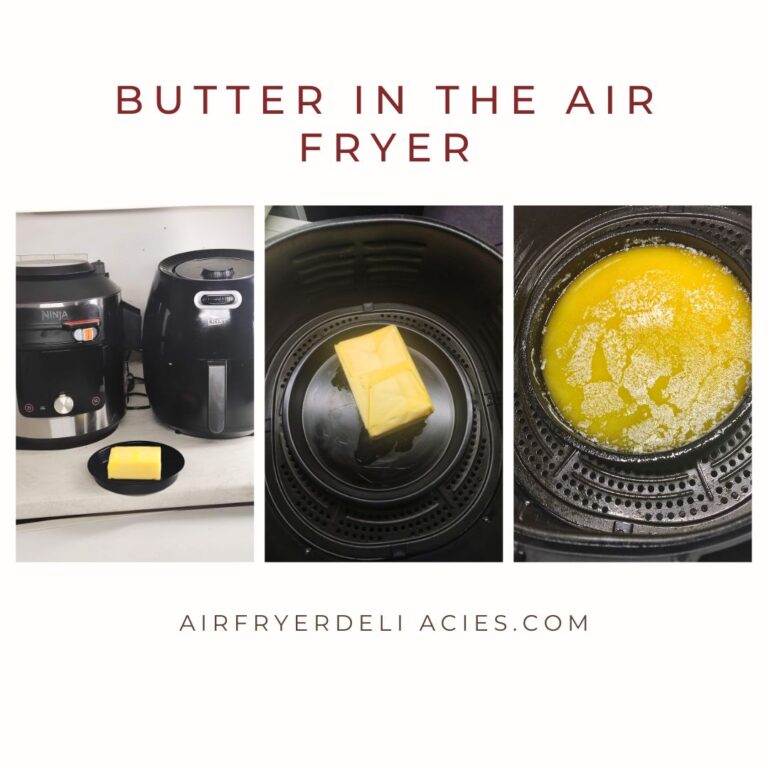In recent years, the debate over which kitchen appliance reigns supreme has heated up: Pressure cooker vs air fryer. Both have garnered a dedicated following for their promise of healthier cooking options and versatility.

Air frying, a method that circulates hot air around the food at high speeds, allows for crispy textures akin to deep frying but with much less oil.
Pressure cooking, on the other hand, seals foods in an airtight environment where high pressure speeds up the cooking process. This method is renowned for preserving nutrients and delivering flavors that remind one of slow cooking but in a fraction of the time.
The confusion often lies in their perceived similarities. Many wonder if these multifaceted appliances offer the same benefits or if one could potentially replace the other.
Pressure Cooker Vs Air Fryer: Understanding the difference
- Understanding Air Frying: Delivers crispy, deep-fried-like textures with minimal oil use.
- Exploring Pressure Cooking: Offers fast, nutrient-rich meals mimicking slow-cooked flavors.
- Comparing Appliances: Reveals distinct benefits, debunking the notion they’re interchangeable.

Differences: Pressure Cooker vs. Air Fryer
| Feature | Pressure Cooker | Air Fryer |
|---|---|---|
| Cooking Method | Uses high pressure and steam to cook food quickly. | Uses rapid air circulation to mimic frying without the oil. |
| Texture | Produces moist and tender results, ideal for soups, stews, and braises. | Creates a crispy and crunchy texture, similar to frying. |
| Health | Retains nutrients well due to the sealed environment and faster cook times. | Offers a healthier alternative to deep frying by using little to no oil. |
| Use Cases | Great for cooking beans, grains, tough cuts of meat, and for making broth. | Best for cooking frozen foods, vegetables, and for reheating leftovers. |
| Cooking Time | Can significantly reduce cooking times for foods that typically take longer to cook. | Generally faster than conventional ovens but not as quick as pressure cookers for certain foods. |
| Versatility | Highly versatile with the ability to sauté, steam, and even make yogurt, depending on the model. | Primarily focused on baking, roasting, and frying, with some models offering additional features. |
Similarities: Pressure Cooker vs. Air Fryer
| Feature | Pressure Cooker | Air Fryer |
|---|---|---|
| Convenience | Designed for quick and convenient cooking. | Offers fast and easy cooking options. |
| Countertop Appliance | Usually sits on the countertop, requiring storage space. | Also a countertop appliance, requiring space for storage. |
| Energy Efficiency | More energy-efficient than traditional ovens by concentrating heat in a sealed environment. | Typically more energy-efficient than ovens due to faster cook times and concentrated heat. |
| Healthier Cooking | Can lead to healthier meals by reducing the need for added fats and preserving nutrients. | Promotes healthier eating by reducing the amount of oil needed for cooking. |
| Safety Features | Equipped with safety valves and locks to manage pressure. | Comes with safety features like automatic shut-off and cool-touch exteriors. |
| Ease of Cleaning | Many models have removable parts that are dishwasher safe. | Often features non-stick baskets and parts that are easy to clean, many of which are dishwasher safe. |
Pressure cooker vs air fryer
Understanding How Air Fryers Work
Many have wondered how air fryers managed to take the culinary world by storm. They harness a combination of high speeds and hot air circulation. This innovative method ensures that foods, from chicken wings to French fries, emerge with that delectably crispy texture. It’s all achieved with much less oil than deep frying. The heart of an air fryer’s functionality lies in its heating element and a powerful fan. Together, they produce hot air that envelops the food in the cooking chamber, cooking it evenly and swiftly. As a result, dishes not only boast a healthier profile due to minimal oil usage but also retain the crispy outer layer that many crave. The process presents a healthier alternative to traditional methods, maintaining flavor while cutting calories.
Diving into Pressure Cooking
Pressure cooking has revolutionized the way we prepare our meals. By harnessing the power of high pressure, electric pressure cookers, including renowned appliances like the Instant Pot, drastically cut down cooking times. Meats, rice, and beans, which once took hours, now can be served in a fraction of the time. This method relies on trapped hot steam increasing the boiling point of water, a principle allowing foods to cook much faster. Electric pressure cookers, often doubling as slow cookers, also maintain the nutrients and flavors trapped inside, making them a healthier option. With built-in safety features, pressure cooking offers not just speed but also peace of mind. Sought-after for their versatility, these appliances can handle a wide range of dishes, from tender chicken wings to succulent whole chickens, proving indispensable in the modern kitchen.
Comparing Cooking Modes
Air fryers and electric pressure cookers stand at virtually opposite ends of the cooking spectrum. The main difference lies in their cooking methods. Air frying leverages hot air circulation at high speeds, mimicking deep frying to produce crispy foods like chicken wings and french fries without much oil. This healthier alternative relies on a heating element and a fan to circulate hot air around the food, ensuring a crispy texture outside and tenderness inside. On the other hand, pressure cooking employs high pressure and high temperatures within a sealed cooking chamber, drastically reducing cooking times.
While air fryers cater to those craving the crispy skin of a whole chicken or the golden exterior of sweet potatoes, pressure cookers are a boon for enthusiasts of slow-cooked flavors in a fraction of the time. They prove invaluable for dishes that benefit from moist heat, such as stews and briskets. Understanding these appliances’ distinctions aids home cooks in deciding which device will best suit their culinary ventures, offering ease of use and diverse cooking modes for varied types of foods.

Which is Healthier?
In the realm of healthy cooking, air frying and pressure cooking have emerged as trailblazers. Air frying had made headlines for using significantly less oil, thus offering a healthier alternative to deep frying. Foods like french fries and chicken wings come out crispy with a fraction of the fat. On the other side, pressure cooking captivates us by locking in nutrients that could be lost through traditional methods. This process is unmatched in its ability to quickly convert a whole chicken into a succulent meal, preserving both moistness and flavor. Consequently, both appliances manifest as champions of nutritious eating, though they serve different purposes. Air fryers allow for a lighter version of our favorite fried foods, while pressure cookers ensure that the sweet potatoes and brussels sprouts are rich in vitamins. The decision between the two, hence, pivots more on the texture preference and the specific health goals one has laid out.

Best Practices for Each Appliance
To harness the full potential of your air fryer or pressure cooker, a few best practices can go a long way. For air fryers, it’s advised to preheat them to achieve that sought-after crispy texture in foods like french fries and chicken wings. A light spray of oil on your food will also enhance this effect, making the air fryer a healthier alternative to deep frying. Cleaning involves removing the basket to wash separately, ensuring no residue builds up.
With pressure cookers, on the other hand, always check that the sealing ring is properly positioned to avoid any steam leaks during high-pressure cooking. For electric pressure cookers like the Instant Pot, keeping the pressure release valve clean is crucial. Quick-release methods can be applied for certain recipes, but natural release is better suited for denser foods like a whole chicken or sweet potatoes, retaining more flavors and nutrients. Always consult your manual for specific cleaning guidelines, as models can vary significantly.
Versatile Cooking: Beyond Basics
Modern air fryers and pressure cookers have evolved far beyond their basic models. These versatile appliances now come equipped with a range of cooking modes, turning them into indispensable kitchen partners. Air fryers, with their ability to circulate hot air at high speeds, have proven effective not only for frying but also for baking and roasting. The Ninja Foodi and Instant Pot Duo Crisp are prime examples of this versatility, embodying both air fryer functionality and traditional pressure cooking capabilities. These appliances allow us to bake soft sweet potatoes, roast a whole chicken to crispy perfection, and even attempt the sous vide method for meats, ensuring a moist and tender texture.
Experimenting with the various functionalities can turn everyday meals into gastronomic adventures. By engaging in slow cooking, deep frying, or even the Maillard reaction for that delightful crust on meats, enthusiasts find these smart kitchen tools essential. The distinct cooking methods offered by pressure cooking and air frying provide a healthier alternative that does not compromise on flavor or texture. Indeed, the key differences lie within their capability to innovate our cooking experiences.
Picking the Right Appliance for Your Kitchen: Differences: Pressure Cooker vs. Air Fryer
Deciding between an air fryer and a pressure cooker will transform your kitchen experience. The choice bubbles down to specific factors such as kitchen space, cooking habits, and budget. If you savor crispy textures like those of french fries or chicken wings, an air fryer will meet your needs. Its heating element and hot air circulation mimic deep frying, minus the oil. With high speeds, air fryers grant a healthier alternative for lovers of crispy foods. On the contrary, a pressure cooker excels in tenderizing types of foods that normally take hours. Think whole chicken or sweet potatoes; the high pressure and steam cook them in a fraction of the time. This device is invaluable for those who value speed and versatility.
Moreover, evaluate your kitchen counter space. Air fryers come in different sizes, but even the basic models require room. Conversely, an electric pressure cooker, especially newer models like the Instant Pot, often incorporates multiple cooking modes like slow cooking or yogurt making, saving you space and money. Considering these aspects, you will find the appliance that seamlessly aligns with your culinary style and space.
Ultimate Lid on the Cooking Conundrum
Throughout our journey into the ultimate kitchen showdown between the pressure cooker and air fryer, several key points emerged. These appliances, each harboring unique benefits, have challenged our traditional cooking methods. The pressure cooker, revered for its high pressure and versatile cooking modes, transforms meals in a fraction of the time. It offers a healthier alternative by preserving nutrients under extreme conditions. On the other hand, the air fryer, celebrated for its crispy textures and less oil usage, grants us the pleasure of indulging in healthier versions of deep-fried favorites.
It behooves us to delve deeper into how these innovative tools, such as the Ninja Foodi or Instant Pot Duo Crisp, satisfy our culinary needs. Whether you dream of succulent chicken wings or crispy french fries, the choice hinges on not just the dish but also on personal health goals and kitchen space. As we embraced the cooking process differences, ease of use, and each appliance’s ability to cater to various types of foods, the verdict became clear.
Let these insights guide you in making an informed decision. Reflect on what aligns with your cooking style, the amount of kitchen counter space you can dedicate, and your aspirations for healthier cooking. The ultimate lid on this cooking conundrum is not about choosing one over the other but rather understanding which appliance best fits your lifestyle.
Want to get to know how your air fryer works?
This article explains in detail!
How to preheat an air fryer.
Disadvantages of an air fryer.
Best Air fryers without Teflon
About the Author
I am Seun, and I love to share my first-hand experience using multiple air fryers. Stick around for yummy delicacies made from the air fryer and many amazing tips on using your newfound Kitchen appliance – the air fryer!




